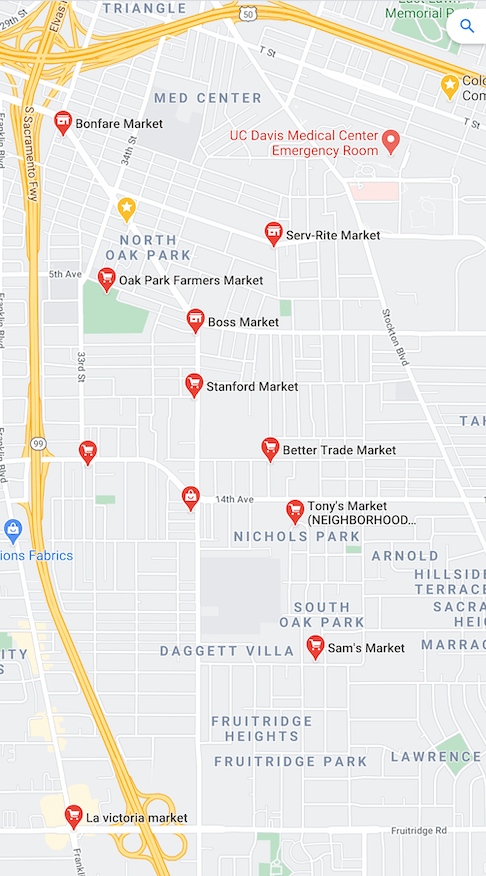My earlier post on corner retail was in preparation for talking about an idea that corner retail should be acknowledged, supported, and promoted in the upcoming Sacramento 2020 General Plan. The general plan tentatively promotes higher density by allowing a reasonable floor area ratio for properties throughout the city, while removing development constraints that add nothing to safety or livability. Assuming the plan and the resulting code to support it does significantly increase the number of homes and people able to live in the city, if the city remains as car-centric as it is, the result will just be less parking availability and more congestion (both of which I’m in favor of, but I recognize most people are not). It would go towards solving the housing issue, but do little for livability and climate change issues.
So what is the solution? A place where people can perform most of their daily activities without driving. In other words, corner retail. The jobs issue is a separate one, though corner retail would also increase the number of jobs within walking distance.

I am not sure exactly how to accomplish this, but I’ll throw out an idea. I don’t think rezoning corner lots from residential to commercial is necessarily the answer, because that might encourage entirely new buildings replacing existing buildings. Obviously many existing buildings would need to be changed to serve as retail, but I don’t think wholesale replacement is good, and it is not respectful of that claim of ‘neighborhood character’ (which is often a cover for concerns not voiced, but is nevertheless a consideration).
Rather, I think a by-right conditional use permit (is that an oxymoron?) is the better solution. That way the building remains similar to what is there now, but becomes functional as a retail location.
Where? I’m partly of mind to say everywhere, every corner. Much of the existing corner retail predates zoning (grandfathered in) or is already under a conditional use permit. But I’m also of mind to limit it to fewer locations, which would be any corner fronted on at least one side by a collector or arterial street. In the lower density parts of Sacramento, I don’t think much corner retail would show up, because it takes a certain density to make retail viable, but there would certainly be more than there is today. Wouldn’t you like to be able to walk to a coffee shop in your neighborhood. Or walk to the market for a few items?
Note that I’m not clearly defining what corner retail is. Does it mean there is only one business present, or allowed, or could it be a few small footprint businesses clustered together? Some of the locations I’ve identified are not on actual corners, but they have the feeling of corner retail. The general plan and the supporting code would have to define corner retail.
Below are two maps of Oak Park, on the left, arterials and collectors, and on the right, GoogleMaps with markets selected. The scales are similar but not identical. As you can see, some corners on arterials or collectors already have corner markets, and there are other corners with retail that is not a market, but there are a number of locations that could have corner retail under my proposal, but do not. I picked Oak Park just because I’d spent time there recently looking for markets and other corner retail (photos below).
The slideshow below shows some of the corner retail, mostly markets, in Oak Park. Note that in general these locations are much more car-oriented than the ones I showed in the central city, because the area is much more car dominated. I will say more about that in the future. It does not include the many, many businesses that are part of commercial zones along Broadway and Martin Luther King. If you zoom in on Google Maps, a commercial area overlay shows up as pale yellow. I am gradually collecting photos of retail in other areas of Sacramento and will eventually post them.















